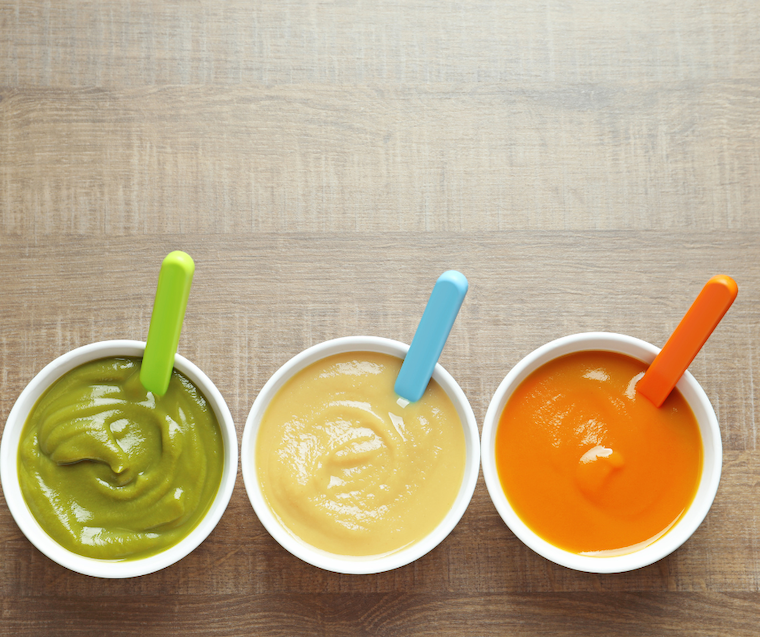
Baby's First Foods Step by Step
This is a guest post for Hey, Milestone by Lucie Thomé of Bébé Foodie.
As a parent to a growing sprout, you've spent six months of your baby's life ensuring they are nurtured and well-fed with breast milk or formula. For many parents, getting their baby fed (even in the milk-only stage) is a challenging but fulfilling milestone that takes time, attention, and patience.
When it's Time for First Foods
Time flies when your baby begins to develop and show curiosity about their surroundings. As your growing baby continues to grow and thrive, you may notice that they're ready to graduate from the bottle or breast to a brand new world of solid foods. If your baby has begun showing signs of readiness like holding up their head, sitting up, or bringing objects to their mouth—those are excellent first signs to prepare them for a new, food journey.
The transition to solid foods is an exciting stage that opens a path to a nutritious diet with essential vitamins such as; zinc and iron. From a holistic perspective, solids also stimulate their senses and awaken their inner foodie with new textures, flavors, unique colors, and fun shapes!
But, like every 'first' in a human's life, there are challenges that come with the process; brand new schedules, safety precautions, food allergies, and, yes, getting food hurled at your face. But, not to fear, there are ways to make their first-time fun and simple, and we're excited to guide you through your baby's first foods to set you up for success!
Redeem your Free Family Nutrition Sample Box here!

Baby's Food Stages 1
It's crucial to remember that every baby is different, and first introductions don't always equate to success. Most of a baby's nutrition comes from formula or breast milk at four to six months, so it isn't a concern if your baby doesn't gravitate towards solids immediately. For instance, with a milk-only diet, some babies prefer formula while others prefer breast milk; the same notion applies to solid foods. Also, while some babies adjust to the introduction to solids quicker than others, others may take longer to adapt.
Whatever pace your baby decides to go, it's completely normal! Therefore, solid foods can be introduced gradually and adapted to your baby's development stages. And remember that at this age, your baby is getting all their nutritional needs thru breast milk or formula. Now that you're ready to jump ship and introduce your baby to a nutritious diet, here are some guidelines to keep in mind:
The Ideal Time of Day to Introduce Solids
Babies accustomed to their bottle or mom's breast may find the introduction of something new and foreign overwhelming. Therefore, it's essential to ensure that your baby's mood is happy and relaxed when feeding solids. The time of the day to introduce solids is entirely up to you, but an optimal time would be a few hours after a feed of formula or breast milk, so your baby can have extra room in their tiny tummies for food.
Morning time is a great place to start since babies are hungry after waking up. However, you don't want to leave too much time apart after a feed because they will look for their regular feeding of milk that they know soothes and satisfies their hunger.
Start Slowly
Seamless transitions begin gradually, with small spoonfuls, and the most efficient way to ease into solids is with the help of formula or breastmilk. You can begin the first few weeks by introducing one solid food a day and slowly work your way up. According to TheBump.com, babies don't typically consume more than an ounce or two in one sitting. As your baby grows and their appetite changes, you can increase the amount as you go. By the 12-month mark, your baby should be eating around four small meals a day accompanied by breast milk or formula.
The Right Textures and Variety
Welcoming solids into your baby's diet must be approached with caution due to safety hazards; that's why it's vital to start the introduction with either smooth purees or soft finger-shaped food if you decide to do Baby-Led Weaning; and depending on your baby's preference. While the idea of soft foods may seem dull, you can experiment with various safe food textures.
According to RaisingChildren.Au, textures assist with speech development and self-feeding in the future. In addition, babies can chew even before their first teeth come in. As your baby develops in the next few months or weeks, your baby can move onto the next stage of textures, such as; roughly mashed, minced foods, and eventually, chopped foods.
Spoon-Feeding Etiquette
Finger foods can be introduced as early as 6 months, and if you are, it's critical to make sure you are cutting finger foods for baby-led weaning into mashable, finger-shaped, or 2-3 inch pieces to avoid choking. Allowing your baby to stimulate their senses by letting them use their hands can be fun and adorable.
However, it's good to start with proper food etiquette to save you from cleaning bigger messes! It's crucial to ensure your baby is sitting upright (to avoid choking) and has a bib around their neck. When spoon-feeding, try positioning the spoon in the middle of your baby's mouth to help get purees down quickly.
After a few feedings with practice, usually, your baby will be able to swallow from a spoon naturally. Whatever method you choose, remember that this is the right one for you and your baby!

Solid Starts First Foods
Baby's First Grains
There isn't any rhyme, rhythm, or scientific evidence suggesting parents or guardians should introduce specific solid foods over another to start with. Nevertheless, store-bought first baby foods are primarily iron-fortified baby cereals that consist of either oat, mixed grains, or barleys that can be easily combined with a baby's milk. Pay attention to labels to avoid high sugar content. Grinding oatmeal in a blender is preferred as it contains less sugar.
Baby's First Vegetables
The first few years of your baby's childhood are an excellent opportunity to introduce vitamin-rich foods. For nutritional purposes, vegetable purees are often recommended by pediatricians. Like the sweet taste of their milk, babies naturally gravitate toward sweeter foods.
So you may want to kick-start their interest in savory foods during the earlier stages by introducing vegetables into their palette, which will set the stage for healthier eating habits. You can start by offering vegetables with softer flavors such as cauliflower, broccoli, spinach, green beans, carrots, or pumpkin. Offering variety is a great way to allow your child to get accustomed to many different flavors and textures.
Baby's First Fruits
Fruits are jam-packed with nutritional benefits, essential vitamins, and minerals to your child's diet. However, not all fruits are great starters for baby-led weaning diets. If you want to begin incorporating fruits into your baby's introduction to solids, you can start with easily digestible fruits such as apples in the form of apple sauce. In addition, apples are a nutritious source of vitamin-c and contain fiber, aiding in constipation. Another favored easy fruit that parents love is mashed bananas, rich in potassium to support muscle and heart function.
According to MayoClinic, it's best to avoid highly-acidic fruits when transitioning to solids like citrus fruits and strawberries. Highly acidic foods are tough on a baby's digestive system as they transition from milk and may cause irritations on their skin and diaper rash. Make sure you monitor for a any reaction when introducing.
Introducing Foods with Allergens
Many parents steer away from introducing wider varieties due to the fear of allergens. While there are many foods that babies are allergic to, the most common culprits are dairy, eggs, fish, and peanuts. In the past, parent's avoided and approached allergens with caution.
However, newer research suggests introducing allergens before their first birthday, because the delayed introduction of food allergens may increase the risk of food allergies or eczema. Like introducing fruits and vegetables, you can start gradually by introducing one food allergen at a time. This helps you gauge which food is responsible for a reaction if it occurs.
According to SolidStarts.com, a few days of daily digestion is enough to establish if a portion of food is tolerated. Allergic symptoms usually happen within a few minutes after food is consumed and as long as two hours after. Talk to your pediatrician; for you to determine the exact allergy or condition. If the symptoms are severe, call 911 right away.
Ready, Set, Food!
First times are never easy, and we want to congratulate you for getting this far! The first 24 months of this transition can impact a child’s eating habits in the future, so it’s essential to establish a strong start from the beginning. Clearly, this new transition isn’t rocket science, and it’s completely normal to feel confusion or certainty as you try to navigate the ropes of solid foods.
However, while there are many techniques and guidelines to remember on this new milestone, this new adventure opens up exciting opportunities for exploration and fun-loving experiences. And remember that yes, you have flexibility! From healthy store-bought options to making a schedule that is convenient to you and your family, options are endless.
At Bébé Foodie, we’re on a mission to guide parents through the introduction to solids. Led by Founder, CEO, and Baby Nutrition Expert Lucie Thomé, we provide a healthy, no-judgment space to help make this new milestone seamless, healthy, and fun! No matter what stage you are in this new journey, with endless options, transparency, and complete flexibility, we offer personalized guidance to help you find the right approach for you and your baby.
There are so many variations you can feed your little one with and expand your baby's palate. But, remember, all it takes is a little bit of patience, the right guidance and laughter.
This is a guest post for Hey, Milestone by Lucie Thomé of Bébé Foodie.
